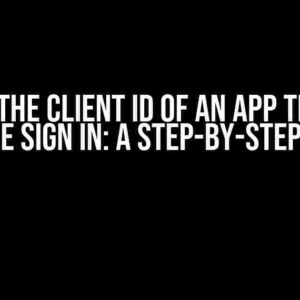Are you tired of dealing with cumbersome APIs and tedious data fetching in your React JS applications? Look no further! In this comprehensive guide, we’ll dive into the world of CWE 201, also known as the fetch function, and explore its capabilities, benefits, and best practices. By the end of this article, you’ll be well-equipped to handle even the most complex data fetching tasks with ease and confidence.
What is CWE 201 (Fetch Function)?
The fetch function, also known as CWE 201, is a built-in JavaScript function that allows you to make HTTP requests to fetch resources from a server. It’s a promise-based API that provides a flexible and efficient way to interact with APIs, servers, and other data sources. In React JS, the fetch function is an essential tool for fetching data and integrating it into your application.
Why Use CWE 201 (Fetch Function)?
So, why should you use the fetch function in your React JS applications? Here are some compelling reasons:
- Simplicity**: The fetch function provides a simple and intuitive way to make HTTP requests, making it easy to integrate with your React JS application.
- Flexibility**: The fetch function supports a wide range of HTTP methods, including GET, POST, PUT, DELETE, and more, giving you the flexibility to customize your requests to suit your needs.
- Performance**: The fetch function is built on top of the Promise API, making it fast and efficient, and allowing you to handle errors and exceptions with ease.
Basic Syntax and Usage
Now that we’ve covered the benefits of using the fetch function, let’s dive into its basic syntax and usage.
fetch('https://example.com/api/data')
.then(response => response.json())
.then(data => console.log(data))
.catch(error => console.error(error));
In this example, we’re making a GET request to https://example.com/api/data, and then parsing the response as JSON using the json() method. Finally, we’re logging the data to the console using the console.log() method.
HTTP Methods
The fetch function supports a range of HTTP methods, including:
| HTTP Method | Description |
|---|---|
| GET | Retrive data from a server |
| POST | Create new data on a server |
| PUT | Update existing data on a server |
| DELETE | Delete data from a server |
In addition to these basic methods, the fetch function also supports other HTTP methods, such as HEAD, OPTIONS, and PATCH.
Handling Errors and Exceptions
When working with the fetch function, it’s essential to handle errors and exceptions properly to ensure that your application remains stable and reliable. Here are some best practices for handling errors and exceptions:
- Use try-catch blocks**: Wrap your fetch function calls in try-catch blocks to catch and handle errors locally.
- Use error handling functions**: Use error handling functions, such as
catch(), to handle errors globally. - Check the response status**: Always check the response status using the
statusproperty to ensure that the request was successful.
try {
const response = await fetch('https://example.com/api/data');
if (!response.ok) {
throw new Error(`HTTP error! status: ${response.status}`);
}
const data = await response.json();
console.log(data);
} catch (error) {
console.error(error);
}
Best Practices and Optimization Techniques
To get the most out of the fetch function, it’s essential to follow best practices and optimization techniques. Here are some tips to help you optimize your fetch function usage:
- Use caching**: Implement caching mechanisms to reduce the number of requests made to the server.
- Use headers**: Use headers to customize your requests and provide additional metadata.
- Use query parameters**: Use query parameters to pass data to the server and customize your requests.
- Use async/await**: Use async/await to write more readable and maintainable code.
const cache = {};
const fetchWithCache = async (url) => {
if (cache[url]) {
return cache[url];
}
const response = await fetch(url);
const data = await response.json();
cache[url] = data;
return data;
};
Conclusion
In conclusion, the fetch function (CWE 201) is a powerful and versatile tool for making HTTP requests in React JS applications. By mastering its syntax, usage, and best practices, you can unlock its full potential and build fast, efficient, and scalable applications. Remember to handle errors and exceptions properly, optimize your fetch function usage, and follow best practices to ensure that your applications remain stable and reliable.
So, what are you waiting for? Start using the fetch function in your React JS applications today and take your development skills to the next level!
Further Reading
If you’re interested in learning more about the fetch function and its applications, here are some recommended resources:
Frequently Asked Question
Got stuck while using the fetch function in React JS? Worry not! Here are some frequently asked questions and answers to help you overcome the hurdles.
What is the purpose of the fetch function in React JS?
The fetch function in React JS is used to make HTTP requests to fetch data from a server or API. It returns a promise that resolves to the response object, which contains the server’s response to the request.
How do I handle errors in the fetch function?
You can handle errors in the fetch function using the .catch() method. This method is called when the promise returned by fetch is rejected. You can also use try-catch blocks to handle errors.
What is the difference between fetch and xhr (XMLHttpRequest) in React JS?
Fetch is a modern replacement for XMLHttpRequest (xhr). Fetch provides a more powerful and flexible way to make HTTP requests, with better error handling and support for promises. Xhr is an older API that is still supported for backwards compatibility.
Can I use fetch to make requests to a different origin?
Yes, you can use fetch to make requests to a different origin, but you’ll need to ensure that the server at the other origin allows cross-origin resource sharing (CORS). This can be done by including the Access-Control-Allow-Origin header in the response.
How do I cancel a fetch request in React JS?
In React JS, you can cancel a fetch request by using the AbortController API. This API allows you to create an AbortController instance, which can be used to cancel a fetch request by calling the abort() method.





